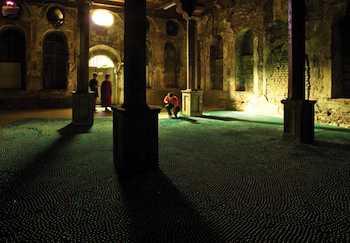The Haskoy quarter of Istanbul, which overlooks the historic Golden Horn inlet of the Bosphorus, was once the site of the gardens and pavilions of the Ottoman Empire sultans. In the late 15th century, it became the refuge for thousands of Jews who were expelled from Spain and Portugal and who built dozens of synagogues in the area. Today, Haskoy is a gritty industrial area where barely a trace of the former synagogues remains—except for one.
 Hidden behind a squalid aluminum foundry and run-down billiard hall is the abandoned Mayor Synagogue, standing as a lonely testament to the Jews of the Ottoman Empire whose descendents lived here for centuries.
Hidden behind a squalid aluminum foundry and run-down billiard hall is the abandoned Mayor Synagogue, standing as a lonely testament to the Jews of the Ottoman Empire whose descendents lived here for centuries.
While its exact origins are in dispute, historians estimate that the Mayor is between 300 and 500 years old. Unlike other historic synagogues of Istanbul, which have been restored to become centers of worship, the Mayor Synagogue was virtually forgotten—used mainly for industrial storage—before it was discovered by Esra Nilgun Mirze, a dynamic Turkish community arts advocate.
Mirze has worked for 18 years with the Istanbul Foundation for Culture and Arts, which organizes international visual and performing arts festivals in Turkey. For the past few years she has been the international relations director for Istanbul 2010 – European Capital of Culture. The Council of the European Union awards the title each year to two or more cities, which then showcase their cultural life and development during a yearlong international festival. In between visits to foreign capitals to promote Istanbul 2010, Mirze has been energetically pursuing her own passion—restoring the Mayor Synagogue not simply as a place of worship, but as an arts center that reflects the diversity of Istanbul’s heritage.
Mirze’s dream is to transform the ancient synagogue into a multicultural arts center that will give young artists an international platform for their work. She aims to use her extensive international contacts throughout Europe and elsewhere to bring the work of young artists to the attention of the international art community. At the same time, she hopes to bring an international perspective to young Turkish artists, who may not have been broadly exposed to the global viewpoints on cultural and religious diversity.
At a time of economic, political and cultural transformation in Turkey, which has faced many challenges as a secular Muslim nation, both from the West and from conservative Islamic critics, Mirze believes that arts and culture may be an ideal force to meet those challenges, particularly with young people.
To promote her vision, Mirze has founded 41 29 Istanbul, a nonprofit organization to renovate the synagogue and sponsor exhibitions and events featuring young artists. (The “41 29” moniker comes from the geographical coordinates of the city of Istanbul.)
While the effort has been a labor of love—and a continual struggle—Mirze’s organization got an unexpected boost from the American artist Serge Spitzer, who visited the Mayor Synagogue and decided it would be the perfect location for an onsite installation. Born in Romania, Spitzer is an internationally renowned artist who uses site-specific installations to explore the relationship between art and locations as they exist in real life. Spitzer’s work has been exhibited in museums around the world, from the Museum of Modern Art in New York to the Museum fur Moderne Kunst in Frankfurt, and he has participated in international exhibitions like Documenta in Germany and the Venice Biennale.
Spitzer was viscerally drawn to the historic, ruined synagogue. “The fact that it is not an isolated art space, with its desolateness and emptiness despite its real existence, drew my interest,” he said.
Spitzer’s installation at the synagogue was titled “Molecular Istanbul” and opened at the site in fall 2009. Spitzer’s work reflects the confluence of art and daily life, and in the Mayor installation he used tons of green and blue marbles that were brought to the site and deposited on the floor of the dimly lit shul. With only a small window providing a thin shaft of light, the thousands of blue and green glass balls lying on the stone floor create a vibrant and mysterious atmosphere. Critics called the installation “breathtaking,” and it drew flocks of visitors during the 2010 European Capital of Culture events.
With Turkey facing a pivotal era in its history—torn between the dynamism of economic development and the pull of traditional values—projects like the Mayor Synagogue, which remind both the Turkish people and the international community of the diverse history of Turkey, are of particular importance. Spitzer believes that although change is inevitable, “Authentic values should not be forgotten while making these changes in the city of Istanbul, which reminds one of a patchwork.”
Mirze believes that the future is bright for her dream of restoring the Mayor Synagogue and for its rebirth as an important center for the arts.
“It is a great opportunity and source of happiness for me that the work of a very significant artist like Spitzer is displayed at a place that will turn into a culture and art center in the future,” she said.
However, she added, “this gives us an even greater responsibility to fulfill the dream.”
For more information about 41 29 Istanbul, visit this article at 4129istanbul.org.
Hoyt Hilsman is an award-winning writer and critic. He is active in politics and international affairs, and was recently a candidate for Congress. His novel, “19 Angels,” a political thriller set in the Middle East, was published in fall 2010.
via Historic Istanbul synagogue reborn as vibrant arts center | Travel | Jewish Journal.

Leave a Reply